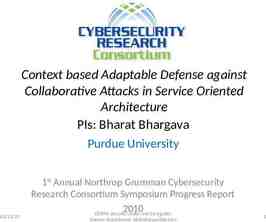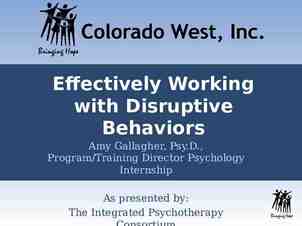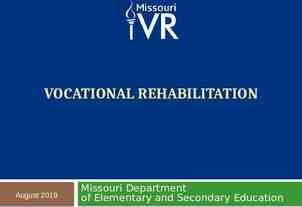Building Culturally Responsive MTSS Systems Lucinda Soltero-González
49 Slides2.39 MB
Building Culturally Responsive MTSS Systems Lucinda Soltero-González Alba Ortiz Letti Grimaldo Denise Schweitzer 2017 LEADERSHIP CONFERENCE 1
Overview Overview of Model Demonstration Projects MTSS for ELs 1. Effective core and supplemental literacy instruction for ELs 2. Data-based decision making for ELs 3. Sustainable implementation of MTSS Instructional Recommendations Q&A 2017 LEADERSHIP CONFERENCE
Acknowledg3ments The work presented here was funded by the Office of Special Education Programs Dr. Grace Zamora Durán, OSEP Project officer Grant #H326M110001 Grant #H326M140002 Grant #H326M11003 Note: The material in this presentation was produced under U.S. Department of Education, Office of Special Education Programs Grant No referenced above. Grace Zamora Durán served as the OSEP project officer. The views expressed herein do not necessarily represent the positions or policies of the Department of Education. No official endorsement by the U.S. Department of Education of any product, commodity, service or enterprise mentioned in this publication is intended or should be inferred. This product is public domain. Authorization to reproduce it in whole or in part is granted. 2017 LEADERSHIP CONFERENCE
Three language programs: Early-exit bilingual, one- and two-way dual language, and Eng lish as a second langua ge Projects in urban, rural, and near-urban areas of Colorado and Texas Slide 4 EL Model Demonstration Projects English learner (EL) population range between 31% and 86% 4 Length of implementation 2017 LEADERSHIP CONFERENCE
MTSS: Response to Intervention High-quality, evidence-based core literacy instruction specific for ELs Students’ language proficiency, cultural background, and educational histories informing literacy instruction Systematic, targeted supplemental instruction 5 2017 LEADERSHIP CONFERENCE
Effective Core and Supplemental Literacy Instruction for ELs 2017 LEADERSHIP CONFERENCE
Meeting the Needs of ELs 1 Culturally and linguistically responsive approaches to literacy instruction 2 High-quality, evidence-based literacy practices for the following: English as a second language literacy instruction Biliteracy instruction 3 Systematic and targeted interventions for students who do not adequately respond to core instruction 2017 LEADERSHIP CONFERENCE
1. Culturally and Linguistically Responsive Literacy Practices Teachers know their students well and establish strong relationships with them and their families. Teachers have high expectations of all students, providing them with needed supports to reach their potential. Teachers use linguistic scaffolds to ensure access to rigorous curricula and instruction. Curricula and instruction validate literacy practices and funds of knowledge from students’ homes and communities. 2017 LEADERSHIP CONFERENCE
2. Core Literacy Instruction for ELs 9 2017 LEADERSHIP CONFERENCE
Core Literacy Instruction: Teaching Vocabulary 2017 LEADERSHIP CONFERENCE
2. Biliteracy Instruction Core biliteracy instruction for ELs also includes the following: Bridging native language literacy skills to English literacy Extending literacy proficiency in both the native language and English 2017 LEADERSHIP CONFERENCE
3. Supplemental Instruction for ELs Supplements—does not replace Aligns with language(s) of core literacy instruction Includes a specific focus on language development Is scaffolded to accommodate students’ level of native language or English language proficiency 2017 LEADERSHIP CONFERENCE
Changes in Instructional Practices Considerable improvement in Tier 1 and Tier 2 literacy instruction English language development in core and supplemental literacy instruction (e.g., vocabulary instruction, dialogue, visuals) Providing differentiated instruction in the general education classroom (for both content learning and ELD) Increased use of methods for developing ELs’ reading fluency, comprehension, word work, and writing (in Tier 1 and Tier 2) Areas of need Attention to cultural responsiveness in curriculum and instruction 2017 LEADERSHIP CONFERENCE
Changes in Instructional Practices Year 1 changes in first grade teachers practice: modeling: 16% to 60% brisk pace: 33% to 60% corrective feedback: 50% to 90% individual turns: 33% to 85% 2017 LEADERSHIP CONFERENCE
Changes in Instructional Practice Percentage of Teachers Implementing with Moderate to High Fidelity YEAR 2 (Full Implementation) Time 1 Time 2 60% 100% YEAR 3 (Sustainability) Time 1 Time 2 96% 96% 2017 LEADERSHIP CONFERENCE
Enhancing Vocabulary and Comprehension “Implementing the routine has helped my students gain new vocabulary that they have been able to use throughout the day, through their journal entries, and when they do readers’ response. Their comprehension has increased because they know how to look for the who and the what is most important when they’re reading their own stories, or in guided reading, or in book clubs.” 1st Grade Teacher 2017 LEADERSHIP CONFERENCE
Findings from a Research Site: Gap Closure DRA Scores for All Students: ITS Approach Time Model: Non-Parametric (Dummies), With Covariates 25 Grade 0 Observed Data Trend for Non-ELL's Trends for Ell's 40 Grade 1 Observed Data Trend for Non-ELL's Trends for Ell's 20 D RA Scores DR A Scores 30 15 10 10 5 0 0 Pre-Year 80 70 Yr 1 Year of Study Yr 2 Yr 3 Pre-Year Grade 2 Observed Data Trend for Non-ELL's Trends for Ell's 80 70 50 40 30 Year of Study Yr 2 Yr 3 Yr 2 Yr 3 Grade 3 Observed Data Trend for Non-ELL's Trends for Ell's 50 40 30 20 20 10 10 0 Pre-Year Yr 1 60 DRA Scores 60 DR A Scores 20 0 Yr 1 Year of Study Yr 2 Yr 3 Pre-Year Yr 1 Year of Study 2017 LEADERSHIP CONFERENCE
Findings from a Research Site: Percent of Students at Benchmark Percent At Benchmark for All Students: ITS Approach Time Model: Non-Parametric (Dummies), With Covariates 1 Grade na Observed Data Trend for Non-ELL's Trends for Ell's Percent At Benchmark .8 .6 .4 .2 0 Pre-Year Yr 1 Year of Study Yr 2 Yr 3 2017 LEADERSHIP CONFERENCE
Overall Changes in Student Outcomes Collectively, the integrated and sustained implementation of key model components improved the overall school-wide delivery of MTSS sufficiently to show statistically significant improvements in reading instruction for ELs in grades K-3 and gap closure between ELs and non-ELs 2017 LEADERSHIP CONFERENCE
Data-Based DecisionMaking for ELs 2017 LEADERSHIP CONFERENCE
Meeting the needs of ELs 1 Assessment tools provide accurate data on English Learners' trajectories toward literacy and/or biliteracy, measuring literacy skills in the native language and/or in English. 2 An assessment plan is in place that includes appropriate tools in the native language and/or English to ensure that student growth is adequately tracked. 3 Assessment procedures generate valid and reliable data for determining instructional placement for individual students and for informing instructional programming decisions for individuals and groups of students. Procedures facilitate appropriate and timely decision-making. 2017 LEADERSHIP CONFERENCE
Importance of Appropriate Assessments Grade % of students Data used identified as being in need of Tier 2 % of students If the following identified as being assessments were in need of Tier 2 used K 8% Tejas Lee 1 40% Tejas Lee or EDL 20% 30% 10% Tejas Lee only EDL only Both 2 41% Tejas Lee & EDL 44% 47% Tejas Lee only EDL only 2017 LEADERSHIP CONFERENCE
Importance of Language Alignment Grade % of students identified as being in need of Tier 2 Data used 2 28% AIMSweb Spanish Fluency 3 21% 69% AIMSweb Spanish Fluency English Maze 2017 LEADERSHIP CONFERENCE
Additional Data During reviews, teachers provide information beyond screening and progress monitoring, such as: Language proficiency Quality of core and supplemental instruction Past educational placement Continuity of enrollment and/or attendance Home and community factors Progress within and across grades 2017 LEADERSHIP CONFERENCE
Overall Changes in Assessment Practices Align assessments Use of multiple, varied and comprehensive assessment data, including assessments in the language of instruction (Spanish and English) 2017 LEADERSHIP CONFERENCE
Purposes for Data-Informed Decision-Making Make decisions about students’ movement within and across tiered instruction. Determine eligibility for referral to remedial or special education programs. Identify school-level and grade-level trends or issues. Evaluate effectiveness of curricula and instructional delivery. 2017 LEADERSHIP CONFERENCE
An Example Percentage of students who enter Tier 2 at the beginning of the year Grade Year 1 Year 3 1 68% 39% 2 36% 10% Percentage of students who exit Tier 2 by the end of the year Grade Year 1 Year 3 1 51% 83% 2 17% 67% 2017 LEADERSHIP CONFERENCE
Changes in Data-Based Decision Making Through systematic, collaborative meetings, teachers could capitalize on their team members’ strengths in different areas. Teachers felt greater “ownership” of all students in their grade level, as opposed to focusing only on students in their respective classrooms. Teachers reported that they were better informed about students’ needs across classrooms, which allowed them to group students more effectively. 2017 LEADERSHIP CONFERENCE
Overall Changes in DecisionMaking Process Elimination of redundant assessments Intentionality in using additional data More frequent discussion of language acquisition and cultural factors 2017 LEADERSHIP CONFERENCE
Sustainability Lessons learned from professional development and sustainability efforts 2017 LEADERSHIP CONFERENCE
Essential Features of Professional Development (PD) for Teachers of ELs Develop a partnership with an instructional leader in the schools who works closely with teachers of ELs to build capacity through PD. Create opportunities for teachers of ELs to provide input in the dissemination of the PD plan to build relationships and establish buy-in. Engage in various PD activities (e.g., classroom observations, feedback sessions, team teaching, coaching, peer observation, self-videoing with self-reflection). Provide opportunities for discussion around refining best instructional practices for ELs and establishing next steps. 2017 LEADERSHIP CONFERENCE
Professional Development Findings All of the teachers reported positive perceptions of job-embedded professional development in reading o Teachers reported job-embedded PD was more beneficial than the traditional PD they had received previously and that they were motivated to implement practices. o They identified the following as important components of job-embedded PD: o Relevant content o Proximity to practice o Longer duration o Opportunity for team growth 2017 LEADERSHIP CONFERENCE
Year 2: Integrating Video into a Collaborative Coaching Cycle 2017 LEADERSHIP CONFERENCE
Fidelity to Practice Teachers Not Implementing Round 1 (N 21) Round 2(N 24) 13 11 10 6 6 3 3 4 2017 LEADERSHIP CONFERENCE
Fidelity to Practice Teachers with Moderate to High Implementation Round 1 (N 21) 15 6 Round 2(N 24) 20 14 16 4 16 1 2017 LEADERSHIP CONFERENCE
Overall PD Findings: Strengths to Achieve Project Goals Leadership is key. Capitalize on existing structures. Take an iterative approach to implementation. Plan collaborative, job-embedded PD to support sustainability, such as the following: – – – – Implementation, team teaching, and coaching Self-observation and peer observation Sharing of findings Planning of next steps Foster self-reflection. Build capacity by supporting teacher leadership. 2017 LEADERSHIP CONFERENCE
PD Findings: Lessons Learned Leadership and teacher buy-in was key in the implementation and sustainability of PD and partnership efforts. Implementation of partnership plans required periodic adjustments based on PD and observation, mentoring, and evaluation evidence. High teacher and principal turnover required creative ways to continue the project for existing participants while bringing on new educators. Culturally responsive MTSS components in literacy instruction and team decision-making challenged educators to rethink their instruction for ELs and adjust. Competing mandated initiatives, curricula, and teacher evaluation requirements created challenges for the partnership members. 2017 LEADERSHIP CONFERENCE
Colorado Sites: Overall Sustainability Findings Increased Culturally and Linguistically Responsive Practices After one year of sustainability: Literacy practices are embedded in daily instruction (i.e., no longer an add-on) Supplemental (Tier 2) more purposefully aligned with Tier 1 Teachers who participated in professional development are supporting/training other teachers Learning activities are modeled for parents rather than telling them what to do Multiple assessments are used; assessment are conducted in the language(s) of instruction Decision-making more culturally/ecologically responsive (student, school, family) District-wide adoption of a new culturally/linguistically responsive referral tool 2017 LEADERSHIP CONFERENCE
Features of Sustainability: Overall Model Development of model through collaborative partnerships – Technical Advisory Board – Stakeholder input and high social validity- teacher buy-in – Responsiveness and flexibility to local needs Gradual release of ownership of the model Coordination of available resources to support educators in implementing model practices 39 2017 LEADERSHIP CONFERENCE
Sustaining the Model: Core Instruction Promotion of teacher-leadership within grade-level teams Building on teachers’ instructional strengths to enhance literacy instruction for ELs High-quality educator tools and resources: clear, user-friendly, and engaging Framework for “anytime” educator support: video models; webbased tools and trainings 40 2017 LEADERSHIP CONFERENCE
Sustaining the Model: Supplemental Instruction Protect core instruction through the development of an intervention block where all students receive targeted small group instruction Group students using grade level data to assign students to specific interventionists for Tier 3, teachers for Tier 2, and tutors. Review groupings after data points to determine if adjustments need to be made to groups or instruction 41 2017 LEADERSHIP CONFERENCE
Features of Sustainability: Data-based Decision Making Pilot and refinement of protocol Stakeholder input and high social validity Collaboration and buy-in at the district level Integration of practices, procedures, and protocols within district RTI Handbook Integration of data-meeting system within existing framework for educator planning and collaboration (PLCs) 42 2017 LEADERSHIP CONFERENCE
Features of Sustainability: Professional Development Coordination of available resources to provide ongoing, jobembedded PD Capacity-building among instructional leaders to promote sustainability Teacher leaders identified and utilized at back to school PD and throughout the year as model classrooms Non-evaluative coaching from administration 43 2017 LEADERSHIP CONFERENCE
Texas Site: Participant Feedback Model Usefulness and Sustainability Model Sustainability 97% of educators rated the model as Likely to Very Likely to be sustained on their campuses Structured Data Meetings 95% of teachers rated them as Useful to Very Useful in determining intervention needs Core Instruction: Read Aloud Routine 95% of educators rated the model for core instruction as Useful to Very Useful to their students 2017 LEADERSHIP CONFERENCE
Sustained Effects (i.e., Dosage) of MTSS for ELs (Immediate vs Extended Time Comparison) 40 Raw Depiction of Dosage Model Line colors indicate length of time (i.e., dosage) ELs beginning in grade 1 were taught within the model (Orange-1 yr.; Blue-3 yrs.) mean(iy dra) 20 30 No Exposure 1 Year 2 Years 3 Years 10 Dosage effect in achievement doesn’t become noteworthy until the third year of implementation 0 Reading achievement progress requires implementation of MTSS with CLR features over time 0 1 grade1 2 3 2017 LEADERSHIP CONFERENCE
Conclusion 2017 LEADERSHIP CONFERENCE
Checklist for Success Instruction: High-quality core literacy instruction for ELs and language development Assessment & decision-making: appropriate tools, intentionality, longitudinal data PD: Job-embedded PD and coaching cycle (differentiation of PD to target local needs) Sustainability: Importance of leadership Plan (policies, training, resources) how to prioritize, process, resources for sustainability 2017 LEADERSHIP CONFERENCE
Practice Briefs Practice Briefs can be found on the Model Demonstration Coordination Center website: http://mdcc.sri.com/cohort5.html 2017 LEADERSHIP CONFERENCE
Questions? Letti Grimaldo [email protected] University of Texas at Austin Lucinda Soltero-González, [email protected] University of Colorado Boulder Alba Ortiz [email protected] University of Texas at Austin Thank you! 2017 LEADERSHIP CONFERENCE






















































